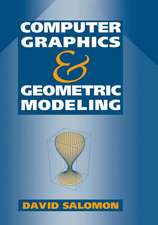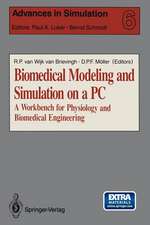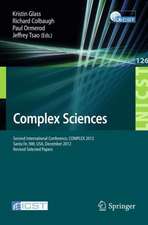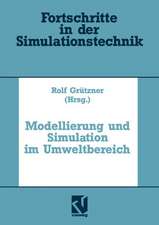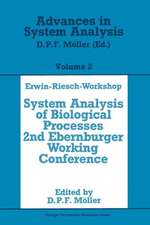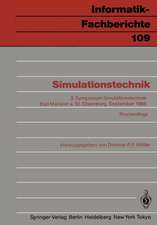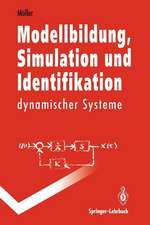Advanced Simulation in Biomedicine: Advances in Simulation, cartea 3
Editat de Dietmar P. F. Mölleren Limba Engleză Paperback – 26 dec 1989
Preț: 328.42 lei
Preț vechi: 410.53 lei
-20% Nou
Puncte Express: 493
Preț estimativ în valută:
62.85€ • 68.25$ • 52.79£
62.85€ • 68.25$ • 52.79£
Carte tipărită la comandă
Livrare economică 22 aprilie-06 mai
Preluare comenzi: 021 569.72.76
Specificații
ISBN-13: 9780387971841
ISBN-10: 038797184X
Pagini: 203
Ilustrații: XI, 203 p. 18 illus.
Dimensiuni: 155 x 235 x 12 mm
Greutate: 0.31 kg
Ediția:Softcover reprint of the original 1st ed. 1990
Editura: Springer
Colecția Springer
Seria Advances in Simulation
Locul publicării:New York, NY, United States
ISBN-10: 038797184X
Pagini: 203
Ilustrații: XI, 203 p. 18 illus.
Dimensiuni: 155 x 235 x 12 mm
Greutate: 0.31 kg
Ediția:Softcover reprint of the original 1st ed. 1990
Editura: Springer
Colecția Springer
Seria Advances in Simulation
Locul publicării:New York, NY, United States
Public țintă
ResearchCuprins
Parallel Processing in Biological Systems.- Multicomputers in simulation.- Evolution in simulation oriented digital computers.- Classification of multicomputers.- Parallel simulation.- Simulation of biological systems and its need for parallel processing.- Simulation example on the AD10 multicomputer.- Concluding notes.- References.- An Elementary Bond Graph Approach to Structured Biological Modeling.- The need for unified graphical structured modeling.- General lines of the presentation.- Bond graph representation of energetical systems.- Hypergraph representation of energetical lumped systems.- The set EP of elementary parts or nodes.- The two elementary connection branches.- Bond graphs: A representation of a subclass of energetical hypergraphs.- The chemical energy domain.- Chemical EBG variables and energy storage elements.- Chemical reaction and dissipation by R-elements based on mass action.- The pseudo bond graph approach to reaction kinetics and compartments.- Representation of kinetic and potential energies by dynamical bond graphs.- Algorithmic representation of idealized physical models by bond graphs.- The EBG representation of an electrical IPM.- Representation algorithms for other systems.- Coupling of bond graphs and informational block diagrams.- Representation of information transfer in BG’s by active bonds.- Coupling of active bonds to BG nodes.- Formulation algorithms: Automatic obtention of simulation routines.- The causal stroke: A graphical marker of causality.- Sequential assignment of causality for elements and junctions.- Algorithmic derivation of the procedural simulation routine.- Conclusion.- References.- Simulation of Typical Physiological Systems.- Recent advances in digital computing.- Success may cause trouble.- Other issues.- Atypical physiological model.- Non-linear relationships.- Algebraic relationships.- Integral relationships.- Summary.- References.- Parameter Estimation: An Advanced Simulation Tool in Biomedicine.- Model building of the renovascular system.- Parameter estimation.- Identification task.- Identification results.- References.- A Review of Respiratory System Applications of Computer Simulation and Modelling Techniques.- Physiological background.- The conceptual basis of modelling the system.- Modelling and simulation as research tools.- Simulation for teaching.- Simulation in respiratory gas exchange teaching.- The MacPuf model.- A computer simulation for training in anaesthesia.- Estimation techniques involving system identification methods.- Applications involving gas exchange models.- Lung mechanics models.- Models for on-line control.- Discussion.- References.- Computer Simulation in Cancer Research.- The cancer problem.- Biological observations of cell growth.- Growth of normal cells.- Growth of tumor cells.- Possibilities of cancer treatment.- Statement of the modeling problem.- Overview of previous work.- Model design.- Fundamental components.- Limitations.- Computer-implementation of the model.- Simulation results and discussions.- Formation of capillaries.- Spread of tumor cells in the cortex.- Tumor angiogenesis effect.- Outlook.- References.- Mathematical Simulation of the Human Thermal System.- Distributed parameter model: Radial dependencies.- Distributed parameter model: Three dimensional dependencies.- Data base.- Physics and mathematics of the passive system.- Metabolic heat production.- Convective heat transport.- Controller equations.- Numerical solution.- Results of simulation.- Distribution of temperatures and profiles in neutral environment.- Control strategy.- Temperature profiles in the cold and in the warmth.- References.- Large-Scale Multiple Model for the Simulation of Anesthesia.- Concept of the large-scale multiple model.- Model design.- Composition of the anesthesia model.- Hemodynamic submodel.- Compartmental transport model.- Baroreceptor control submodel.- Pharmacodynamic submodel.- Simulation results.- Conclusions.- References.








